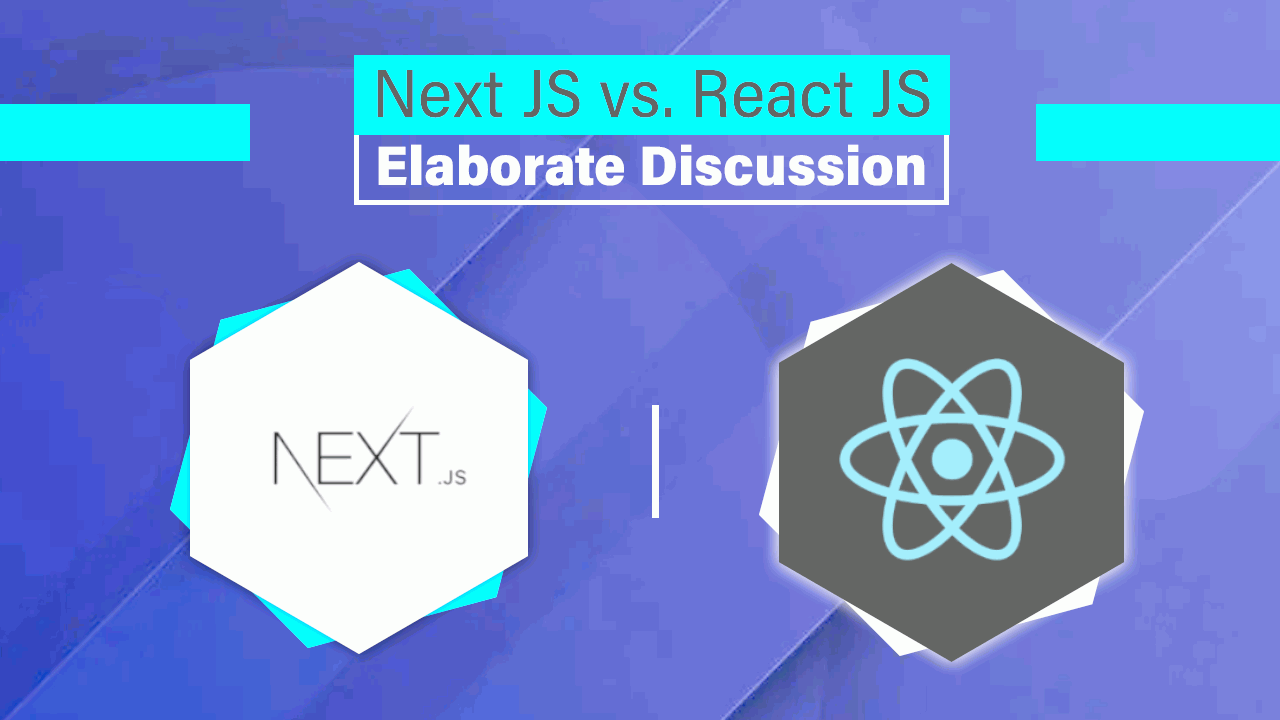Introduction
Developing web-based applications has been much easier in these days with the touch of some software libraries or frameworks. A developer always prefers to go for certain frameworks that are easy to learn and use.
When it comes to building websites, React JS comes to contention because of the extraordinary features and privileges. React provides robust performance and a streamlined development experience.
The front-end development approach is blazing fast by dint of this technology. No doubt it comes with all the functionalities to create dynamic websites. But React finds full completion paired with Next JS.
Next JS is the next dominant web framework that allows creating a ready-to-go application. It helps the developers to build an interactive user interface with additional functionalities.
A developer can use it to create React applications as it abstracts all the crucial development setups to create a typical React application.
With so many features and a tremendous web development ecosystem, it’s comprehensively used in the field of web applications.
However, if you’re committed to knowing elaborately about Next JS vs. React JS, you may hang on here for a while. We’re going to illustrate the core features, advantages, working mechanisms, and other aspects of these two JavaScript libraries below.
Next JS vs. React JS: Which is Better by Performance?
- Use React.js if you’re building a simple client-side application and don’t need features like server-side rendering or automatic code splitting.
- Use Next.js if you need server-side rendering for better performance and SEO, automatic code splitting for optimized loading times, and a simpler way to handle routing in your React applications.
What is Next JS?
Next JS is an open-source framework created by Vercel. It comes with some additional features and functionalities to create ready-to-go applications.
By integrating with React JS, it can develop single-page applications at ease. Unlike React, it can perform server-side rendering more exquisitely. It features automatic building size optimization and supports static export.
No matter where data is coming from, it can ensure pre-rendering and faster development compilation.

It’s getting highly popular with front-end developers because of the excellent documentation system and a preview mode. To be honest, Next JS comprises some features that React has been missing for years.
It can boost up the performance of a site more massively compared to React JS. A developer finds fine tweaks to webpack/babel configuration and basic SEO practices through the Next JS.
It will be no wonder if Next JS becomes the prime framework of JavaScript in the near future.
What are the key features of Next JS?
Next JS is blessed with some extraordinary and developer-friendly features and functionalities. As a whole, it provides everything a developer needs to accomplish something fascinating.
It’s evolving fast and incorporating some innovative modules. Let’s discover the key features of Next JS.
Fully server-rendered pages:
The most distinctive feature of Next JS is the seamless server-render system. It doesn’t care where data is coming from; it can extend functionality to include applications rendered on the server-side.
Normally, Next JS pre-renders every page. It generates HTML for every page and supports pages with dynamic routes. In the server-side rendering method, HTML is originated on each request.
The server-side rendering mechanism needs no extra configuration to boost the performance.
A static generation without data:
Next JS has brought about a new revolution in the web development sector through the stable incremental static generation. A developer can straightforwardly generate static content dynamically through it.
By fetching the particular URL, it preliminary saves a static page and serves it statically. In addition, it accepts the new paths dynamically to make static generation without data.
Dropping of getInitialProps:
It’s a fantastic feature of Next JS that is not available to other frameworks. By eliminating the concept of getInitialProps, it has releases the concerns of having a single function execute on both server-side and static environments.
It ensures a quick solution by integrating the getServerSIdePros and getStaticPros methods. That means you could create static output through the static method and server-side function from the server.
Webpack 5 support:
It renders some magnificent performance and bundles optimization facilities to the developers coupled with webpack 5. By making the core lighter, it makes the applications faster than ever before. Besides, it drops support for deprecated things in webpack 4 to make the applications robust.
Consistent caching for page bundles:
Consistent catches for pages bring up optimal support for the web developers. A developer doesn’t need to download all the CSS/JS again to shift a new application. It allows persistent catching even if pages are not changed. It’s absolutely a great feature of this premium JavaScript framework.
Out of the box support for Sass modules and TypeScript:
Both Sass and TypeScript provide a great developer experience. These ensure excellent support to make an application more compelling. Sass is used to power CSS and TypeScrips is applied to have module-based support.
But it’s not a wonder that most of the libraries are not compatible with these. But fortunately, Next JS can ensure out-of-the-box support for these impactful technologies.
Lamba function supports:
Lamba function is a stunning feature of object-oriented programming languages. It’s mostly used in Python to make the coding easier. Nobody expects such an excellent function can’t be applied in JavaScript.
But it has come true as Next JS supports Lambda function to execute a statement in a single life.
SEO friendly:
To be honest, the search engine has a deep intimacy with Next JS. A web application developed with Next JS seems always favorable to the search engines.
The API routes, dynamic content fetching, and stale-while-revalidate features put it in high demand.
What are the advantages of Next JS?
Next JS provides some standout advantages to web developers. It’s unique in terms of performance, competence, and efficiency. Let’s see the core advantages of Next JS.
It works fast:
Next JS applications work fast because of the static site generation and server-side rendering method. A developer finds the rock-solid performance to reach the development goal through it. It ensures optimal optimization convenience to makes the applications blazing rapidly.
It’s easy to learn and deploy:
A developer can easily switch to Next JS as it’s simple. The straightforward learning curve and easy syntax make it highly manageable to the coders.
It can be deployed to full-stack React applications as it includes preview and production deployments. A developer finds a professional deployment pipeline with a few clicks.
It offers API routes:
Through Next JS, it seems easy and quick to build APIs. The developers can manipulate necessary APIs within applications if it needs any third-party APIs. As a result, it becomes simple to keep tokens secret and perform proxy requests.
It’s customizable:
The developers always wanted to have a customizable babel or webpack configuration. And Next JS brings up such a fascinating facility. It lets the user customize babel or webpack configuration at ease. Besides, it allows the user to add webpack loaders or babel plugins.
When to use Next JS?
Next JS is responsible to provide web solutions. It has a wide working arena. Some of the major fields are given below:
Building functional websites:
A functional website comprises a myriad of functionalities. It needs to work faster and execute all the operations to the letter. Quick rendering of components or data is essential in this case.
And Next JS can work accordingly to ensure optimal performance. In addition, it’s prompt to render applications on the server. As a result, the load times become faster and seamless.
Building a landing page:
When it comes to building a simple landing page for marketing purposes, Next JS shines. It offers all the required privileges to create a compelling page that can lead the enormous revenue. Many more marketing materials can also be developed through it.
Making websites SEO friendly:
Next JS adapts to the search engines and takes the best care of search engine optimization. The server-side rendering method makes it efficient for creating SEO-compliant e-commerce sites. It also leaves some extraordinary marks on catching the optimal attraction of search engine bot.
What is React JS?
React JS is one of the most popular and used front-end libraries. It comes with a lot of ready-made tools to build the user interface. In react, everything is considered a component.
It allows the developers to create their own workflows. Day by day, it’s evolving and making web development easier. This open-source JavaScript framework conforms to the functional programming paradigm.
It leaves no hinders in development productivity. It’s applicable for enterprise-grade applications. Besides, it keeps dependencies like webpack and babel.

It’s responsible only for taking care of the view layer. React basically uses virtual document object modules to make web applications faster.
It allows multiple users at a time to work on each component. By breaking a complex user interface, it makes a website highly manageable to the users.
It features many extensions to provide application architecture support. Creating dynamic web applications has been easier as it offers a server-side rendering method.
Why React is the best?
Reach, by all means, the best front-end development framework. It has some extraordinary features that make it highly adorable. Some of the major advantages of React are given below:
Improved performance:
React ensures the optimum performance of an application. It can create a website faster and tackle all the potential issues.
As the virtual DOM compares the component’s previous states and updates the items, it seems efficient to carry out all the functionalities within less time.
Small learning curve and easy to code:
It’s known to all that React is easy. It combines some effective modules to keep the code as simple as possible. The small learning curve makes it easy to master by spending only a few days.
A developer requires less coding to develop a dynamic application. Compared to other frameworks, its code often doesn’t get complex.
Unidirectional data flow:
As React follows unidirectional data flow, the developer can nest child components within parent components. Resulting, it becomes easier to keep track of data and debug errors. The single direction data flow always informs the developer of instant correction in the course of coding.
Dedicated tools:
React is launched with some dedicated tools. The tools make the overall process of creating an excellent user interface straightforward. Besides, some extensions and great properties provide superior ease in developing web applications.
What are React JS interview questions?
The demand for React JS developers is always high. A developer might face some questions when he or she attends an interview.
The recruiters want to know the queries about the functionality, working methods, components, history, and much more stuff during the interview session. This is because they want to examine the candidates if they’re a good fit for the job.
The interview questions also help the authority of the company to realize the competence of a developer. There are some common and crucial interviews questions the developer need to respond to prove themselves.
The “React JS interview questions” can be a great resource to have all the questions together.
Final words
React has been dominating the web sector over the years. Its excellent features and user convenience push it in high demand. Only a few JavaScript frameworks are as viable as it; Next JS is one of them.
Both React JS and Next JS are ideal for developing dynamic websites. These are close to in terms of performance and advantages. Next JS is evolving at its own speed; no doubt it will arise as a most-used library in the near future.
However, having mastery in both technologies is a definite plus point to professional developers.
These are easy to learn, user-friendly, and highly impactful. Both the frameworks have reduced the JavaScript limitations and brought about a new dimension to the web development field.
Moving from server-rendered HTML to client-rendered HTML becomes facile with the invention of these modern technologies.





